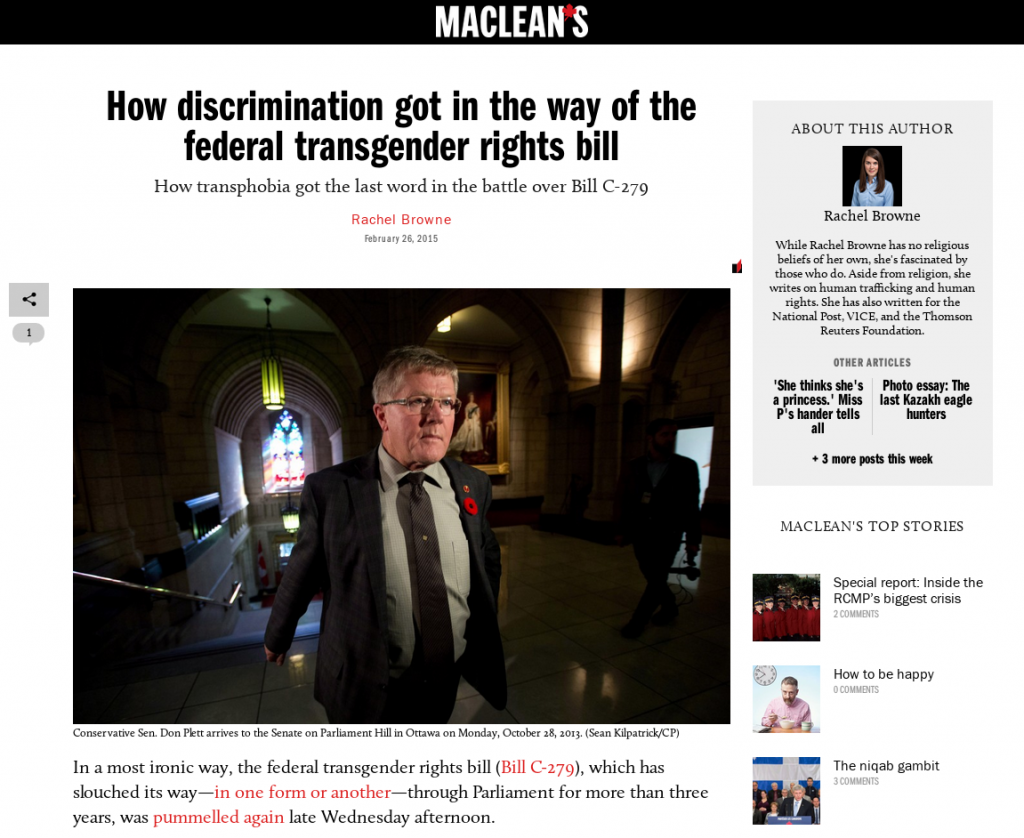Note: I’ve replaced slurs for trans women in the quotes below with the appropriate terms. These substitutions are identified with brackets.
The bill informally known as the “trans rights bill” is dead.
Bill C-279 was introduced in September 2011 as An Act to amend the Canadian Human Rights Act and the Criminal Code (gender identity and gender expression.) It died in August 2015 when the parliamentary session came to a close before the bill could reach royal assent. I’ve already discussed the bill’s contents, origin and much of its progress through Parliament in a previous blog entry.
This outcome was not a surprise. Efforts to introduce these protections had been going on since 2005 with C-392 (38th Parliament), C-326 (39th Parliament) and C-389 (40th Parliament.) None had passed. The Conservatives opposed Bill C-279 and the party had a majority in both the House of Commons and Senate.
Three years after this latest bill was introduced it was recognized with fair certainty that this effort would also fail. As the MP who introduced the bill surmised in June 2014:
“It’s dead,” Randall Garrison, the Member of Parliament championing the bill, told me. “I’ve given up hope.”
The Conservatives didn’t merely oppose the bill. They fundamentally supported the discrimination that this bill was seeking to address. Over the course of Bill C-279’s journey through Parliament, the party would establish itself as the largest openly transphobic organization in Canada.
The Conservative’s actions would be correctly identified as “discrimination” and “transphobia” by mainstream press like Maclean’s.

How transphobia got the last word in the battle over Bill C-279″ reads Maclean’s article.
The Conservatives would deliberately stoke public fear around transgender women by portraying their use of innocuous activities, such as using washrooms, as a threat to (presumably cisgender) women and children.
This fear mongering was done to the detriment of transgender people, 97% of whom had already avoided public spaces out of fear, including 57% who had avoided washrooms. The Conservatives would also repeatedly claim that recognizing the rights of trans people would enable sexual assaults despite being informed in both the House of Commons and Senate that this was factually false. Not a single jurisdiction in Canada or the US that had passed similar anti-discrimination laws had experienced a rise in sexual assault as a result.

Conservative MP Rob Anders’ statements in Parliament were emblematic of these attitudes. Following a petition he wrote up for his constituents to sign, he stated:
Mr. Speaker, I stand today to present, on behalf of thousands of people who sent these to my office, petitions in opposition to Bill C-279, otherwise known as “the bathroom bill”, that would give [transgender women] access to women’s public washroom facilities. These constituents feel that it is the duty of the House of Commons to protect and safeguard our children from any exposure and harm that would come from giving a [woman] access to women’s public washroom facilities. I present thousands of signatures on behalf of the riding in Calgary West, and I know that there are many others that have gone to other members in this place.
Former president of the Conservative Party Senator Plett, appointed to the senate by the current Conservative Prime Minister Stephen Harper, would make the link with pedophiles:
Whether or not it is called “the bathroom bill,” it allows for pedophiles to take advantage of legislation that we have in place.
He would also argue that cisgender people were having their rights infringed by allowing trans people to use the same facilities:
I want you to tell me, Senator Mitchell, when you say that 0.3 per cent of society is trans, how their rights can trump the rights of my five-year-old granddaughter walking into a change room, a [transgender woman] walking into a bathroom.
Conservative MP Dean Allison suggested that transgender people were getting “special rights” if they were allowed to use the correct washroom and repeated the myth that it would enable sexual assault:
The fact is that creating a right to gender identity and gender expression would likely result in [transgender girls] having access to girls’ bathrooms. As the bill would also give special rights to those who simply consider themselves to be transgendered, the door would be open to sexual predators having a legal defence to charges of being caught in a women’s washroom or locker room.
While the rhetoric was discriminatory, the Conservatives did not regard it as such. Senator Don Plett took offense to the suggestion that his stance was discriminatory:
Mr. Dyck, you have in your testimony used a comparison of trans people not being allowed in certain areas. You’ve used a comparison of Blacks not having been able to be allowed. Mr. Garrison used the same analogy when I asked him about my five- or six-year-old granddaughter not wanting to go into the bathroom or a change room with a [transgender woman]. He inferred that it was the same as my granddaughter not wanting to go into the bathroom with an Asian or a Jew. I found that tremendously offensive. I do not believe there is any comparison, when we talk about colour or race, to somebody who is [transgender].
Beyond the transphobic rhetoric, the Conservative’s choice of witnesses in committee was further evidence that the party was more vested in drumming up irrational fears of trans people than in discussing the issues they faced. Issues like:
- 50% of trans people made less than $15,000 a year.
- 87% of trans students felt unsafe in places at school.
- 39% of trans people had been turned down a job for being trans.
- 34% of trans people had been subject to verbal threats or harassment.
- 20% of trans people had been assaulted due to their gender identity/expression.
- The governments of Quebec, Prince Edward Island, Saskatchewan, Yukon and the Northwest Territories required trans people to be sterilized in order to amend documents to reflect their gender.
The Conservatives did not bring on a single transgender person or expert familiar with transgender issues to serve as a witness on this bill about transgender discrimination. They instead brought on the likes of REAL Women of Canada who had never worked with trans people and whose only link to the matter was their established prejudice towards trans people. REAL Women of Canada objected to trans people being accepted at all as evidenced by their press release:
Please ASAP fax, email or phone your MP to ask that he or she oppose Bill C-279, with or without amendments. The major effect of this bill is that transgendered, transsexual and sexually confused individuals will be given full protection re employment, services, housing, etc in public institutions under federal jurisdiction. These behaviors will be “normalized”, accepted and protected.
Meanwhile, on the legislative front, protections for gender expression were stripped from the bill in exchange for a chance at a modicum of support from the Conservatives. That was half the bill. As NDP MP Randall Garrison explained in February 2013:
We need the compromise amendments in order to hang on to the support of the 15 Conservatives who voted in favour at 2nd reading and then the bill will pass. We are hopeful he will allow them.
Then in February 2015 the Conservatives amended Bill C-279 to make discrimination against transgender people legal. The Toronto Star quoted Liberal senator Grant Mitchell in an article entitled “Trans rights bill amendment would bar trans people from public washrooms“:
“The very act that is designed to prohibit discrimination is being amended to allow discrimination,” he said during the meeting.
The Conservatives justified their actions asserting that transgender women were a threat to vulnerable persons:
“This act will no longer allow [transgender women] to identify as female and gain access to vulnerable persons,” he said during the meeting.
This is the eviscerated bill that would die in August 2015.
The Conservatives got their way. They used a lot of vitriolic rhetoric and fear mongering to get there. And in doing so, the Conservative Party of Canada would establish themselves as the largest openly transphobic organization in this country.
Many Conservatives seemed unable to accept that they had been prejudicial to trans people. Senator Plett who rewrote C-279 to legalize discrimination had this to say when he was called transphobic:
I am offended that Ms. Page has implied that I am “transphobic”, and I am appalled that she would suggest my amendment could have anything to do with violence against the community.
Similarly, Conservative MP Joan Crockatt who voted against the trans rights bill didn’t see any contradiction with wanting to march in the Calgary Pride parade. An event that is for, among other things, supporting trans people. The Conservative Party wanted to march in Vancouver Pride, and saw no issue with doctoring the Trans Equality Now pledge that all participating political parties had to sign as to remove the actual pledge for trans equality. They did not end up marching.
As a final note, it was suggested that the Conservatives purposefully stalled the bill as to kill it. NDP MP Randall Garrison expressed that this might be their intent in an interview he gave in November 2014:
“I believe their intention is to kill the bill by delay,” Mr. Garrison told The Globe and Mail.
It certainly seems plausible. The bill’s lack of progress was an anomaly. 43 private members bills were passed in this parliamentary session. Of those, 39 were introduced after Bill C-279. The extent to which this was delayed was so notable that it was reported on by newspapers at the time, including The Globe & Mail and The Ottawa Citizen.
During the vote in the House of Commons, every single one of the 150 NDP, Liberal, Bloc, or Green Party MPs who voted did so in support of the bill. Meanwhile, 132 Conservative MPs voted against it. So it certainly stands to reason that this bill would have passed had the Conservatives not been transphobic.

Comments
One response to “When The Bigots Won”
My only complaint about this article that you wrote is that in the picture you took from the Maclean’s article, on the right side, is a link to another article, “How to be happy”. That link does not work as it is in a screen-captured picture. Now I will never know how to be happy, and will have to rely on the medication my doctor gives me… because, of course, Google is so difficult. 🙂